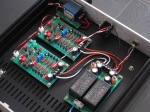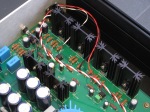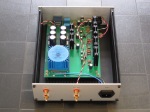There’s an old saying that ”you should never meet your heroes”, because you might be disappointed. I understand where the saying comes from, but it’s actually something I have been trying to do – at least meeting some of my various “audio heroes”. There are a couple of examples here and here, and this post is another example (plus there are a few more I haven’t gotten to yet… 😊 ).
At first look, this is simply another discrete headphone amplifier. However, the design was published in 1985 in a Danish magazine called Ny Elektronik so it was already fairly old when I started reading about it in the mid-90’es or thereabouts (the magazine itself folded in 1989…). It’s one of the designs that I remember reading about and being very intrigued about even before the internet and before I started building headphone amps “for real”.
Back then, a dedicated headphone amp was really a “niche” item, but as a teenager without the space or the budget for expensive speakers I had already found out that headphones were a “shortcut” to good sound that I could not otherwise afford or use, so I had already “caught the bug” which then only became stronger when I found headwize and later head-fi online in 2000/2001.
I actually still have a photocopy of the original magazine article – made at my local library back when you had to buy photocopies by the page – but a few years ago someone pointed me to an online library of all these old magazines (back to the mid-70’es) so I have an electronic copy as well, which is what I stumbled upon on my hard drive again a few months ago.
Part of the reason I never built this amp originally was that I could not make the PCB from my photocopied magazine article and also because the article mentions using low-noise (2SD737/2SB786) transistors. However, when I looked at it again more carefully I actually realized that everything I needed is still available (the low-noise transistors are an option, not a requirement) and so all that was needed was therefore a new PCB layout which wasn’t too much of a problem once I got started.
Apart from making the board single-channel and removing some onboard voltage regulation that I did not think was necessary I’ve left the design as-is. The only change otherwise was to reduce the gain – the original gain is a poweramp-like 28.5x, which I guess makes sense if you had high-impedance headphones and a 1980’es turntable as the source, but I’ve dropped it down to about 5x which is much more reasonable for today’s use (and honestly still a bit on the high side).
The technological development hasn’t been all bad though, because where the original design mostly specified 5% resistors (except the gain resistors), now 1% is pretty much standard. I’ve also “uprated” the power ratings a little bit, so where the original resistors were 1/8W and 1/4W I’ve used 1/4W and 1/2W. I did some outline calculations on the dissipation and the original bias setting seems quite high, so in the interest of reliability I changed the resistors and I plan to bias the amp a bit lower.
Now I’ve only had time to do basic testing on this, but it powers up, biases up well, the DC-servo works as expected and it plays clean audio – so thus far I am very happy. Still need to check thermal stability and listen to it a bit more and then I’ll make the files public in case anyone else wants to have a go at it.





















